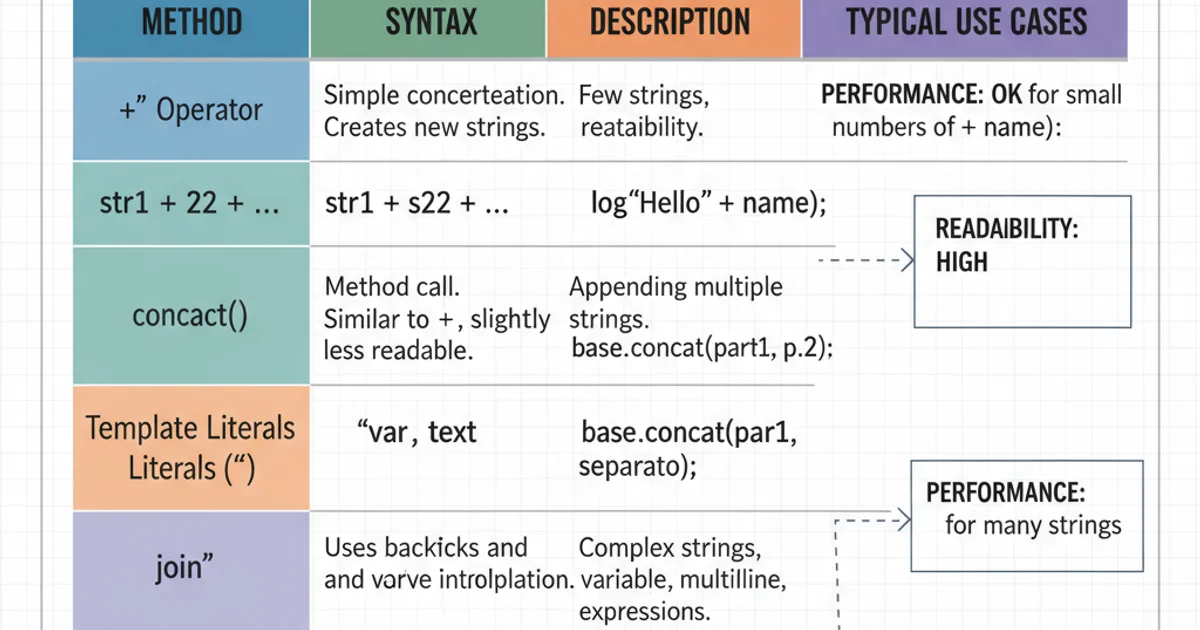How can I build/concatenate strings in JavaScript?
Categories:
Mastering String Concatenation in JavaScript

Explore various methods for building and combining strings in JavaScript, from basic operators to modern template literals, and understand their performance implications.
String concatenation is a fundamental operation in JavaScript, allowing you to combine multiple strings into a single, larger string. Whether you're building dynamic messages, constructing URLs, or formatting output, understanding the different techniques and their nuances is crucial for writing efficient and readable code. This article will guide you through the most common methods, discuss their use cases, and provide insights into best practices.
Traditional Concatenation: The '+' Operator
The most straightforward and widely recognized way to concatenate strings in JavaScript is by using the + operator. This operator works intuitively, joining two or more strings together. While simple, it's important to be aware of its behavior, especially when dealing with non-string types.
const firstName = "John";
const lastName = "Doe";
const fullName = firstName + " " + lastName;
console.log(fullName); // Output: "John Doe"
const age = 30;
const message = "Hello, my name is " + fullName + " and I am " + age + " years old.";
console.log(message); // Output: "Hello, my name is John Doe and I am 30 years old."
Basic string concatenation using the + operator.
+ operator, if one of the operands is a string, JavaScript will coerce the other operand into a string before concatenation. This can sometimes lead to unexpected results if you're not careful with mixed types.Modern Concatenation: Template Literals (Template Strings)
Introduced in ECMAScript 2015 (ES6), template literals provide a more powerful and readable way to work with strings, especially when dealing with multiple variables or multi-line content. They are enclosed by backticks (`) and allow for embedded expressions using the ${expression} syntax.
const firstName = "Jane";
const lastName = "Smith";
const age = 25;
const greeting = `Hello, my name is ${firstName} ${lastName} and I am ${age} years old.`;
console.log(greeting); // Output: "Hello, my name is Jane Smith and I am 25 years old."
const multiLine = `This is a string
that spans multiple
lines.`;
console.log(multiLine);
Using template literals for cleaner string interpolation and multi-line strings.
flowchart TD
A[Start String Concatenation] --> B{Choose Method}
B -->|Simple, Few Variables| C[Use '+' Operator]
B -->|Complex, Multi-line, Expressions| D[Use Template Literals]
C --> E[Result: Concatenated String]
D --> E
E --> F[End]Decision flow for choosing string concatenation methods.
Advanced Concatenation: Array.prototype.join()
For scenarios where you need to concatenate a large number of strings, especially those stored in an array, Array.prototype.join() can be a very efficient and elegant solution. This method creates and returns a new string by concatenating all of the elements in an array, separated by a specified separator string.
const words = ["Hello", "world", "from", "JavaScript"];
const sentence = words.join(" ");
console.log(sentence); // Output: "Hello world from JavaScript"
const pathSegments = ["users", "admin", "profile"];
const urlPath = "/" + pathSegments.join("/");
console.log(urlPath); // Output: "/users/admin/profile"
const emptySeparator = ["a", "b", "c"].join("");
console.log(emptySeparator); // Output: "abc"
Concatenating array elements using Array.prototype.join().
+ and template literals are generally sufficient for most cases, join() is often more performant for concatenating many strings, as it avoids the creation of numerous intermediate string objects that can occur with repeated + operations.Concatenation Best Practices and Performance
When choosing a concatenation method, consider readability, maintainability, and performance. For simple, few-variable concatenations, the + operator is fine. For more complex strings, especially those with embedded expressions or multi-line content, template literals are the preferred modern approach due to their superior readability. For joining many strings from an array, Array.prototype.join() is typically the most performant.

Comparison of JavaScript string concatenation methods.
In older JavaScript engines, repeated + operations could be inefficient due to immutable string nature, leading to new string allocations for each concatenation. Modern JavaScript engines have optimized the + operator significantly, often making its performance comparable to or even better than join() for a small number of concatenations. However, for very large numbers of strings, join() still holds an advantage.